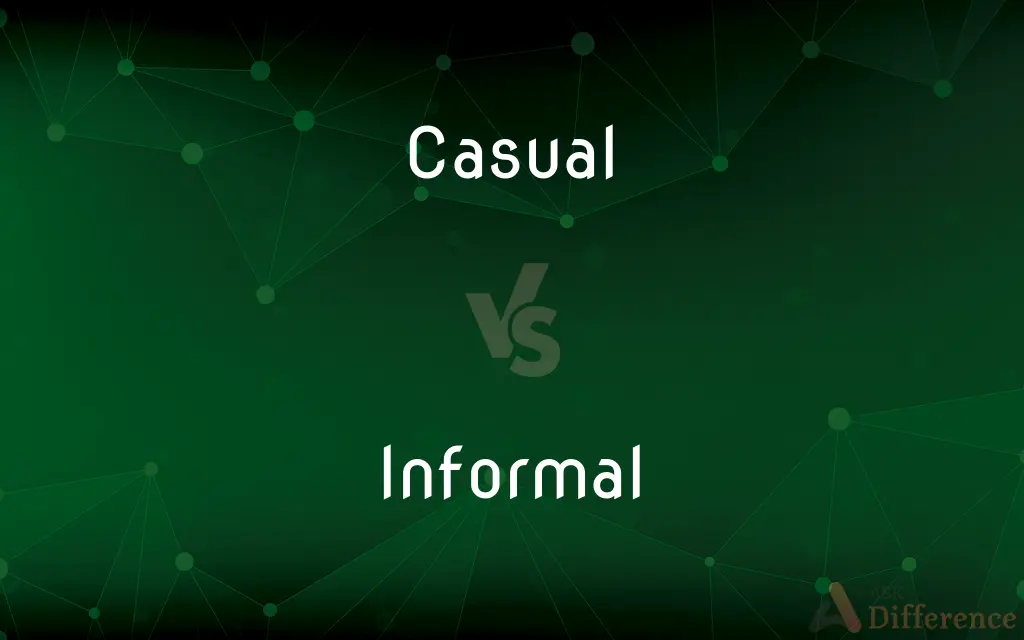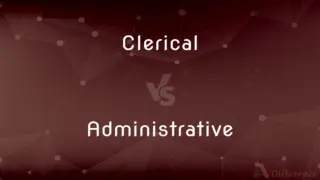Casual vs. Informal — What's the Difference?
By Fiza Rafique & Maham Liaqat — Updated on March 11, 2024
Casual wear is often chosen for comfort and self-expression, whereas informal wear, while also relaxed, follows more specific social guidelines.

Difference Between Casual and Informal
Table of Contents
ADVERTISEMENT
Key Differences
Casual wear encompasses a wide range of clothing options meant for comfort and personal expression, typically suited for everyday use without strict dress codes. It includes items like jeans, T-shirts, and sneakers, emphasizing ease and personal choice. On the other hand, informal wear, also known as "smart casual" or "business casual," strikes a balance between casual and formal attire. It's less relaxed than casual wear, incorporating elements like collared shirts, blouses, and dress shoes, intended for occasions that require a neat appearance without the formality of business or evening attire.
Casual attire is all about personal comfort and individuality. People opt for casual clothing for daily activities, emphasizing ease, functionality, and self-expression. Jeans, T-shirts, hoodies, and sneakers are staples of casual wear, offering maximum comfort for various casual settings. On the other hand, informal attire, though still relaxed, leans towards a more polished look suitable for office environments, casual business meetings, or dining at a moderately upscale restaurant. It includes pieces like dress pants, skirts, collared shirts, and loafers, which are a step up in formality from typical casual wear but still provide a level of comfort and flexibility.
The occasion often dictates the choice between casual and informal wear. Casual attire is perfect for most day-to-day activities, such as running errands, hanging out with friends, or a casual day at home. It's the go-to choice for environments where there is little to no expectation for dressiness. Conversely, informal wear is often preferred for events or settings that require a tidy appearance without being overly formal, such as a business casual office, informal dinners, or networking events. This dress code bridges the gap between casual comfort and the need to present oneself in a more polished, professional manner.
The versatility of casual and informal attire allows for a range of options within each category. For casual wear, the focus is on simplicity and personal style, allowing for a wide variety of clothing choices without concern for strict dress codes. This can include anything from graphic tees and denim shorts to casual dresses and comfortable footwear. Informal wear, while also flexible, tends to lean towards classic, timeless pieces that are more structured and refined, such as button-down shirts, blazers, and dress shoes, which are adaptable yet maintain a level of formality suitable for certain social or professional contexts.
Understanding the distinction between casual and informal wear is crucial for navigating social and professional settings appropriately. Casual attire is synonymous with ease and relaxation, ideal for personal downtime or activities that don't require a specific dress code. Informal attire, while not as strict as formal wear, still adheres to a standard that is appropriate for professional or semi-formal environments, ensuring a presentable and somewhat polished appearance. This knowledge helps individuals make informed decisions about their wardrobe choices, ensuring they are suitably dressed for various occasions.
ADVERTISEMENT
Comparison Chart
Definition
Clothing chosen for comfort and personal expression, suitable for everyday activities.
A balance between casual and formal, appropriate for professional or semi-formal settings.
Examples
Jeans, T-shirts, hoodies, sneakers.
Dress pants, collared shirts, blouses, dress shoes.
Occasions
Day-to-day activities, casual outings.
Business casual offices, informal dinners, networking events.
Key Characteristics
Emphasis on comfort, ease, and individual style.
Neat, tidy appearance without full formality; more structured than casual.
Flexibility
High, with a focus on personal preference and comfort.
Moderate, leaning towards classic and refined choices within a relaxed framework.
Compare with Definitions
Casual
Emphasizes personal comfort and individual expression.
His casual attire reflected his laid-back personality.
Informal
Typically includes collared shirts, blouses, and smart shoes.
For an informal meeting, she wore a blouse and dress pants.
Casual
Clothing designed for comfort and ease, ideal for everyday use.
She wore her favorite jeans and a graphic T-shirt for a casual day out.
Informal
Straddles the line between casual comfort and a polished look.
His informal outfit was carefully chosen to look professional yet comfortable.
Casual
Best suited for day-to-day activities and informal gatherings.
She opted for casual wear for the weekend barbecue.
Informal
A relaxed yet tidy style of dress, a notch above casual wear.
He dressed in informal wear for the business luncheon.
Casual
Offers the greatest flexibility in terms of clothing choices.
Casual wear allows her to mix and match pieces according to her mood.
Informal
Suitable for professional environments that don't require formal attire.
Informal wear was perfect for the office's smart casual dress code.
Casual
Includes a wide range of comfortable and relaxed clothing options.
For a casual look, he chose a hoodie and sneakers.
Informal
Provides some flexibility while adhering to a more polished aesthetic.
Informal wear gave her the opportunity to express her style in a professional setting.
Casual
Relaxed and unconcerned
A casual attitude to life
Informal
Not formal or ceremonious; casual
An informal gathering of friends.
A relaxed, informal manner.
Casual
Not regular or permanent.
Informal
Not being in accord with prescribed regulations or forms; unofficial
An informal agreement.
Casual
Happening by chance; accidental
He pretended it was a casual meeting
Informal
Suited for everyday wear or use
Informal clothes.
Casual
Without formality of style or manner, in particular (of clothing) suitable for everyday wear rather than formal occasions
An ideal coat for casual occasions
A casual short-sleeved shirt
Informal
Characterized by nontechnical vocabulary, simple sentence structure, and relatively few explicit transitions, as typified by spoken language
Informal discourse.
Casual
A person who does something irregularly
A number of casuals became regular customers
Informal
Not formal or ceremonious.
An informal get-together
Casual
Clothes or shoes suitable for everyday wear rather than formal occasions
She designs women's casuals
Informal
Not in accord with the usual regulations.
An informal agreement
Casual
A youth belonging to a subculture characterized by the wearing of expensive casual clothing and frequently associated with football hooliganism.
Informal
Suited for everyday use.
Informal clothes
Casual
Being without ceremony or formality; relaxed or informal
A casual evening with friends.
Informal
(of language) Reflecting everyday, non-ceremonious usage.
Casual
Unpremeditated or offhand
A casual remark.
Informal
(gardening) Not organized; not structured or planned.
Casual
Suited for everyday wear or informal use
Casual clothing.
Informal
Not in the regular, usual, or established form; not according to official, conventional, prescribed, or customary forms or rules; irregular; hence, without ceremony; as, an informal writing, proceeding, or visit.
Casual
Not serious or thorough; superficial
A casual inspection.
A casual understanding of French.
Informal
Deranged in mind; out of one's senses.
These poor informal women.
Casual
Showing little interest or concern; nonchalant
"speaks with casual aplomb about being shot at" (Janelle Brown).
Informal
Not formal;
Conservative people unaccustomed to informal dress
An informal free-and-easy manner
An informal gathering of friends
Casual
Occurring or being such by chance
"in the first months when I was pregnant, before it was obvious to the casual observer" (Anne Roiphe).
Informal
Not officially recognized or controlled;
An informal agreement
A loose organization of the local farmers
Casual
Occurring at irregular or infrequent intervals; occasional
Casual employment at a factory.
A casual correspondence with a former teacher.
Informal
Used of spoken and written language
Casual
Employed on an irregular basis
Casual workers.
Informal
Having or fostering a warm or friendly atmosphere; especially through smallness and informality;
Had a cozy chat
A relaxed informal manner
An intimate cocktail lounge
The small room was cozy and intimate
Casual
Socialized with only occasionally; not close or intimate
A casual acquaintance.
Casual
One that serves or appears at irregular intervals, especially a temporary worker.
Casual
Casuals Casualwear
Sent my casuals to the cleaners.
Casual
A soldier temporarily attached to a unit while awaiting permanent assignment.
Casual
Happening by chance.
They only had casual meetings.
Casual
Coming without regularity; occasional or incidental.
The purchase of donuts was just a casual expense.
Casual
Employed irregularly.
He was just a casual worker.
Casual
Careless.
Casual
Happening or coming to pass without design.
Casual
(of behavior, usage, or milieu) Informal; relaxed.
Tone in casual interactions
Casual
(of clothing or utensils) Designed for informal or everyday use.
Business casual
Pants in the casual wear collection
Casual
A worker who is only working for a company occasionally, not as its permanent employee.
Casual
A soldier temporarily at a place of duty, usually en route to another place of duty.
Casual
A member of a group of football hooligans who wear expensive designer clothing to avoid police attention; see casual (subculture).
Casual
One who receives relief for a night in a parish to which he does not belong; a vagrant.
Casual
A player of casual games.
The devs dumbed the game down so the casuals could enjoy it.
Casual
(fandom slang) A person whose engagement with media is relaxed or superficial.
Casual
A tramp.
Casual
Shoes suitable for everyday use, as opposed to more formal footwear.
Casual
Happening or coming to pass without design, and without being foreseen or expected; accidental; fortuitous; coming by chance.
Casual breaks, in the general system.
Casual
Coming without regularity; occasional; incidental; as, casual expenses.
A constant habit, rather than a casual gesture.
Casual
One who receives relief for a night in a parish to which he does not belong; a vagrant.
Casual
Marked by blithe unconcern;
An ability to interest casual students
Showed a casual disregard for cold weather
An utterly insouciant financial policy
An elegantly insouciant manner
Drove his car with nonchalant abandon
Was polite in a teasing nonchalant manner
Casual
Without or seeming to be without plan or method; offhand;
A casual remark
Information collected by casual methods and in their spare time
Casual
Suited for everyday use;
Casual clothes
Everyday clothes
Casual
Occurring or appearing or singled out by chance;
Their accidental meeting led to a renewal of their friendship
Seek help from casual passers-by
A casual meeting
A chance occurrence
Casual
Hasty and without attention to detail; not thorough;
A casual (or cursory) inspection failed to reveal the house's structural flaws
A passing glance
Perfunctory courtesy
Casual
Employed in a specified capacity from time to time;
Casual employment
A casual correspondence with a former teacher
An occasional worker
Casual
Characterized by a feeling of irresponsibility;
A broken back is nothing to be casual about; it is no fooling matter
Casual
Natural and unstudied;
Using their Christian names in a casual way
Lectured in a free-and-easy style
Casual
Not showing effort or strain;
A difficult feat performed with casual mastery
Careless grace
Common Curiosities
How does informal wear differ from casual wear?
Informal wear is a step above casual, suitable for settings that require a tidy appearance but not full formal attire.
Is there a specific occasion for wearing casual attire?
Casual attire is suited for day-to-day activities, casual gatherings, or any event without a strict dress code.
What defines casual wear?
Casual wear focuses on comfort and personal style, ideal for everyday activities and relaxed settings.
What are the key elements of casual wear?
Key elements include comfort, ease, and a wide range of personal expression through various clothing options.
Can jeans be considered informal wear?
Jeans can be part of an informal outfit if paired with more polished pieces, such as a blazer or a collared shirt.
What should I wear for a business casual environment?
For a business casual setting, opt for informal wear like dress pants, skirts, collared shirts, or blouses.
Can sneakers be worn as informal wear?
Sneakers can be acceptable in some informal settings, especially if they are clean and more on the stylish side.
Is it acceptable to wear casual clothes to the office?
It depends on the office dress code; some may allow casual attire on specific days, while others require at least informal wear.
How can I elevate my casual outfit to informal wear?
Add a structured piece, like a blazer or dress shoes, to a casual outfit to elevate it to informal wear.
How do I choose between casual and informal wear for an event?
Consider the event's setting and expectations; opt for casual for relaxed gatherings and informal for events requiring a neat appearance
Share Your Discovery

Previous Comparison
Clerical vs. Administrative
Next Comparison
Disheveled vs. MessyAuthor Spotlight
Written by
Fiza RafiqueFiza Rafique is a skilled content writer at AskDifference.com, where she meticulously refines and enhances written pieces. Drawing from her vast editorial expertise, Fiza ensures clarity, accuracy, and precision in every article. Passionate about language, she continually seeks to elevate the quality of content for readers worldwide.
Co-written by
Maham Liaqat














































